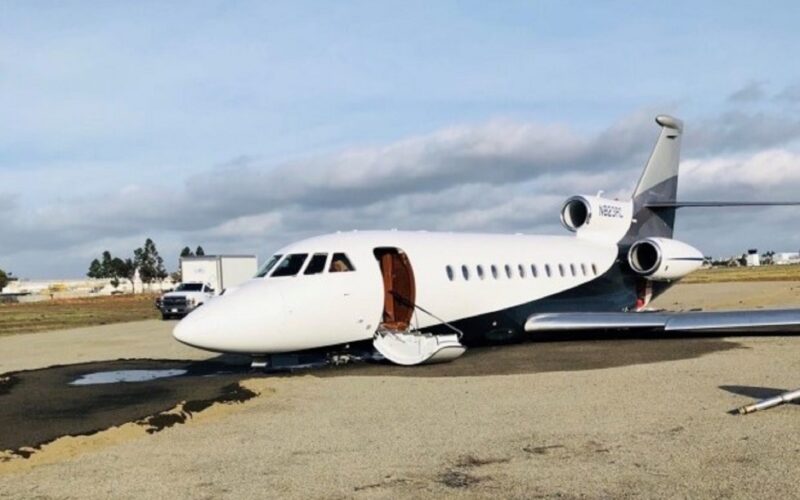An investigation looking into why a Dassault Falcon 900EX private jet overran the runway during take-off has found that the Pilot In Command (PIC) “did not hold any valid pilot certificates at the time of the accident”.
According to the National Transportation Safety Board (NTSB), all the PIC’s certificates had been revoked by the Federal Aviation Authority (FAA) two years prior to the crash due to his “falsification of logbook entries and records”.
On February 13, 2021, shortly before midday, the Falcon 900EX overran the end of the runway 28R at Montgomery-Gibbs Executive Airport (MYF), San Diego, California.
The Falcon was due to travel to Ellison Onizuke Kona International at Keahole (PHKO), Hawaii.
However, the plane failed to take-off, overran the departure end of the runway by about 315 feet and struck a berm, which sheared off all three-landing gear.
The airplane slid an additional 230 feet and came to rest on a gravel overrun pad. The airplane sustained substantial damage to the wings and fuselage, and the fuel tanks ruptured, but thankfully there was no fire.
The report, published by the NTSB in June 2023, said accompanying the PIC and first officer onboard were two passengers and one flight attendant, neither of whom suffered injuries.
“The flight crew later stated that at rotation speed, the captain applied back pressure to the control yoke; however, the nose did not rotate to a take-off attitude. The captain attempted to rotate the airplane once more by relaxing the yoke then pulling it back again, and, with no change in the airplane’s attitude, he made the decision to reject the take-off by retarding the thrust levers and applying maximum braking,” the report stated.
A review of performance data indicated that the flight crew attempted to take-off with the airplane 2,975 lbs. over the maximum take-off weight (MTOW), a center of gravity (CG) close to the most forward limit, and an incorrect stabilizer trim setting.
“The digital flight data recorder (DFDR) data indicated that the captain attempted take-off at a rotation speed 23 knots (kts) slower than the calculated rotation speed for the airplane at maximum weight. Take-off performance showed the departure runway was 575 ft shorter than the distance required for take-off at the airplane’s weight,” the NTSB explained in its report.
Additionally, the PIC had never held a type rating for the accident airplane and had started, but not completed, training in the accident airplane model before the accident.
The captain stated he was employed directly by the owner of the airplane and had previously flown another airplane for the same owner.
The first officer, who was also employed directly by the owner, had accumulated about 16 hours of flight experience in the make and model of the airplane and was not authorized to operate as pilot-in-command.
Probable Cause and Findings
The NTSB determined the probable cause(s) of this accident to be: “The flight crew’s operation of the airplane outside of the manufacturer’s specified weight and balance limitations and with an improper trim setting, which resulted in the airplane’s inability to rotate during the attempted take-off. Contributing to the accident was the captain’s lack of proper certification and the crew’s lack of flight experience in the airplane make and model.”
Due to COVID restrictions, the NTSB did not travel to this accident, and data were gathered by responding representatives from FAA and the airplane manufacturer, Dassault Aviation.

